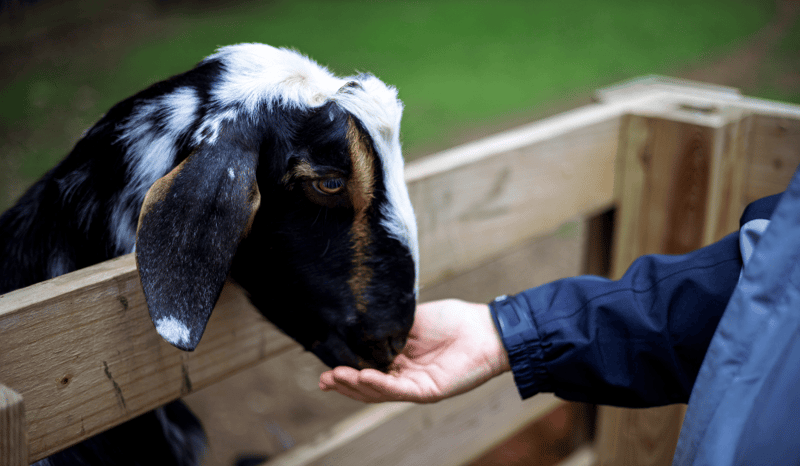
We explore the hidden cruelty behind petting zoos and why these attractions are unsafe, unethical, and can be harmful for both animals and children.
A goat chewing on a toddler’s sleeve. A bunny passed from hand to hand. A piglet plopped into a stroller for a photo. At first glance, petting zoos might seem like a wholesome family activity—an opportunity for children to interact with animals and “learn” about farm life or wild animals. But behind the Instagrammable moments and catchy slogans like "fun for the whole family" lies a much darker reality.
So, let’s ask the questions we all should be asking: Are petting zoos ethical? And, are they safe for anyone involved—human or animal?
The Illusion of Education
Petting zoos are often marketed as educational experiences. But what are children really learning? That animals exist for our entertainment? That it’s acceptable to touch, grab, or feed animals whenever we please? These messages normalize a deeply troubling dynamic: one where human interaction is prioritized over animal well-being.
True education should foster respect and empathy for animals, not reduce them to furry props in a mobile cage or playpen.
The Cruelty Behind the Cutest Exhibits
Whether the animals are farmed species like goats, sheep, and pigs, or wild animals like wallabies, turtles, or even monkeys, petting zoo cruelty is often hidden behind smiling mascots and hay bales.
Here’s what you’re not seeing:
- Constant handling and overstimulation: Being passed from child to child or crowded by noisy visitors causes stress and anxiety for animals, especially “prey species” like rabbits or guinea pigs.
- Lack of veterinary care: Many mobile or roadside petting zoos cut corners, skipping necessary check-ups or parasite control to save money.
- Inappropriate living conditions: Animals are often kept in cramped, unsanitary environments—sometimes in trailers between events, without proper food, water, or shelter.
- Babies sold, bred, or discarded: To keep the attraction fresh, petting zoos rely on a constant supply of baby animals. When they grow too big, many are sold at auction or worse, sent to slaughter.
Even worse? Some petting zoos allow the public to bottle-feed animals—an activity that can disrupt natural feeding schedules and lead to malnutrition or aspiration pneumonia if done improperly.
Risk to Children: More Than Just a Nibble
Petting zoos aren’t just harmful for animals. They’re risky for the people interacting with them, too.
Zoonotic diseases—illnesses that jump between animals and humans—are a real threat. Infections like E. coli, salmonella, ringworm, and even cryptosporidiosis have all been linked to petting zoos and other animal exhibits (like reptile shows), especially when handwashing facilities are inadequate or non-existent.
In fact, according to the CDC, outbreaks of illness linked to petting zoos and animal exhibits occur every year, some with life-threatening consequences, particularly for young children.
Petting Zoos and Bird Flu: A Dangerous Combination
If the animal cruelty issues weren’t enough, there’s now an alarming public health concern making its way into petting zoos: Highly Pathogenic Avian Influenza (HPAI), also known as bird flu.
In 2024 and 2025, bird flu outbreaks have swept through the US, infecting not only poultry farms and wild birds—but also animals in petting zoos and mobile exhibits. In some cases, entire flocks were killed after exposure, and children who interacted with infected animals were monitored for flu-like symptoms.
Why is this especially concerning?
- Close contact between birds and humans, especially children with developing immune systems, increases the risk of zoonotic transmission.
- Petting zoos often lack biosecurity measures used in commercial or more regulated facilities.
- Animals from multiple sources are often kept in close quarters, making it easy for viruses to spread undetected.
It’s not just a problem for birds either—mammals like cows have been infected, too. When humans get too close to sick animals in unnatural environments, we open the door to another potential pandemic.
The takeaway? No animal should suffer for entertainment, and no child should be exposed to deadly viruses for a photo op.
Ethical Alternatives Exist
We get it—people love animals (we do, too!). But there are better ways to foster that connection than forcing animals to endure constant handling, confinement, and travel for entertainment.
Instead of petting zoos, families can:
- Visit a reputable, GFAS-accredited animal sanctuary (not a roadside zoo in disguise).
- Watch live wildlife webcams or documentaries.
- Read books or attend virtual classes about animal behavior and habitats.
- Volunteer at or support ethical rescues that prioritize animals’ needs, not profits.
When animals are allowed to live on their terms, they can teach us more than a selfie ever could.
It’s Time to Rethink What’s “Cute”
The truth is, petting zoos teach all the wrong lessons. They reinforce the idea that animals exist for our amusement, not as individuals with needs, emotions, and the right to live free from harm.
So, the next time you’re invited to visit a petting zoo or see one pop up at a local fair, ask yourself: “Is the momentary joy worth the lifelong suffering of the animals involved?”
The good news is that you can help World Animal Protection end the cruelty hidden behind petting zoos. Support legislation that protects farmed animals and restricts exploitative roadside attractions. And, always choose animal-friendly alternatives that respect wildlife and domestic animals alike.
Ready to get started? Join our FREE Animal Champions community today to take action.